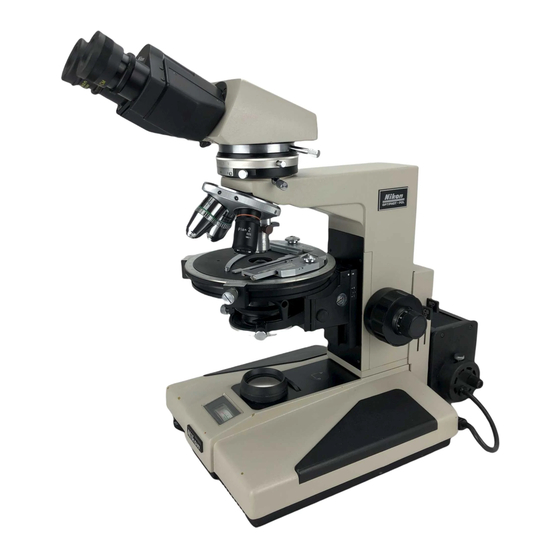Nikon OPTIPHOT-POL 사용 설명서 - 페이지 16
{카테고리_이름} Nikon OPTIPHOT-POL에 대한 사용 설명서을 온라인으로 검색하거나 PDF를 다운로드하세요. Nikon OPTIPHOT-POL 28 페이지. Polarizing microscope

V.PHOTOMICROGRAPHY
Prepare the following
equipments in addition to
the OPTIPHOT-POL
microscope main body.
*
Nikon Microflex
*
Trinocular
eyepiece tube "TP"
*
CF PL Projection lens
1. CF PI:.Projection Lenses
The combined
use of the CF P objectives and
CF PL Projection lenses is essential.
For the same total magnification,
select a com-
bination
of the highest possible objective power
and lowest possible projection
lens power to
achieve
the
utmost
image
definition
and
contrast.
2.
Illumination
1) Checking the illu mination
Unevenness in the illumination
will show
up
more
conspicuously
in photomicro-
graphy than in observation. Consequently,
before
taking
a photograph,
recheck the
positioning
and centering of the lamp and
the correct adjustment of the condenser.
2) Selection of voltage and filter
The color temperature
of the light source
varies with the voltage being used. There-
fore,
in
color
photomicrography,
the
selection
of voltage and filter
is essential
(for the result to be obtained).
Table 3.
Standard Selection
Film
Voltage
Filter
9
NCB 10 is to be used
type
film
Tungsten
type
8
Remove NCB 10
Remove NCB 10
film
Over 6
Contrast fi Iter(green),
etc. is usable
Table 3 shows the standard combination.
Depending
upon the make of the film,
different
color renditions
may result. It is
recommended that in addition
to the NCB
10 filter
a color compensation
filter
(CC
filter),
available
from
the film
manufac-
tu rer, be used.
3.
Shutter Speed
Desirable shutter speeds for least vibration
are
1/4 ~ 1/15 sec. Adjustment
of the image bright-
ness for
color
photomicrography
should
be
made by means of the NO filters.
4. Manipulation of Field and Aperture
Diaphragm
In photomicrography,
the adjustment
of the
field diaphragm is important
for the purpose of
limiting
extraneous
light which causes flare in
the
microscope
image. Stop
down
the dia-
phragm so as to get an illuminated
area slightly
larger than that of the picture field. By adjust-
ing the aperture diaphragm, a change of depth
of focus, contrast
and resolution
of image is
attainable.
Select a size suited to the purpose.
Generally speaking, the aperture diaphragm,
is
properly
stopped down to 70 ~ 80% of the
aperture of the objective being used.
5. Focusing
Focusing for photomicrography
can be done
with
the observation
tube
of the trinocular
eyepiece tube "TP"
or by using the Microflex
finder.
1)
Adjust diopter
•
Using binocular of eyepiece tube:
Use
4X
or 1
OX
objective.
Insert the mask eyepiece into
either of
right
or left eyepiece sleeve that
is ac-
customed to usual use. Adjust the diopter
ring to bring the double cross line in the
view field center into focus. (Fig. 28)
Then focus the specimen image also on the
central area of the mask by means of the
focus knob of the microscope.
The diopter
of another eyepiece is to be
adjusted by focusing specimen rotating the
diopter
ring without
using the microscope
focus knob.
Rotate the mask eyepiece so as the mask
positions as shown in Fig. 32.
